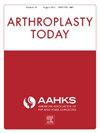The Impact of Cementing Techniques on Implant Longevity in Relation to Keel Length in Persona and NexGen Knee Arthroplasty: A Comprehensive Study
IF 1.5
Q3 ORTHOPEDICS
引用次数: 0
Abstract
Background
The aim of this study was to investigate the efficacy of our modified cementing technique in reducing the rate of aseptic tibial loosening focusing on its relationship with keel length.
Methods
Every participant who underwent primary total knee arthroplasty (TKA) between August 2014 and September 2022 with a minimum of 4-year follow-up using 1 of 3 implants were included: Persona + conventional cementing technique; Persona + modified cementing technique; and NexGen LPS-Flex. The modifications applied include better preparation of the bone surfaces and the cancellous bone cavities, pressurizing the cement and interstitial fluid suction at the same time, applying a layer of cement on the surfaces of the tibia and implant, and immobilizing the limb. Kaplan-Meier analyses were performed to estimate survivorship.
Results
A total of 988 of 1039 primary TKAs (95.1%) were included with follow-up of 89.26 ± 7.32 months. Twenty eight (2.83%) TKA required revisions due to aseptic tibial loosening; 3 (1.1%) in the NexGen group, 21 (6.9%) in the conventionally cemented Persona group, and 4 (0.9%) within the modified cemented Persona group. Aseptic loosening occurred at a mean of 69.00 ± 2.65, 34.57 ± 22.90, and 68.50 ± 3.42, respectively. Survivorship for aseptic loosening was 98.9%, 93.1%, and 99.1% at 8 years, respectively. The revision rate for early (during the first 24 months) aseptic loosening was 4.6% in the conventionally cemented Persona group. No early aseptic loosening reported in other 2 groups.
Conclusions
In conclusion, meticulous cementing techniques can reduce the rate of tibial loosening in shorter keel designs.
求助全文
约1分钟内获得全文
求助全文
来源期刊

Arthroplasty Today
Medicine-Surgery
CiteScore
2.90
自引率
0.00%
发文量
258
审稿时长
40 weeks
期刊介绍:
Arthroplasty Today is a companion journal to the Journal of Arthroplasty. The journal Arthroplasty Today brings together the clinical and scientific foundations for joint replacement of the hip and knee in an open-access, online format. Arthroplasty Today solicits manuscripts of the highest quality from all areas of scientific endeavor that relate to joint replacement or the treatment of its complications, including those dealing with patient outcomes, economic and policy issues, prosthetic design, biomechanics, biomaterials, and biologic response to arthroplasty. The journal focuses on case reports. It is the purpose of Arthroplasty Today to present material to practicing orthopaedic surgeons that will keep them abreast of developments in the field, prove useful in the care of patients, and aid in understanding the scientific foundation of this subspecialty area of joint replacement. The international members of the Editorial Board provide a worldwide perspective for the journal''s area of interest. Their participation ensures that each issue of Arthroplasty Today provides the reader with timely, peer-reviewed articles of the highest quality.
 求助内容:
求助内容: 应助结果提醒方式:
应助结果提醒方式:


